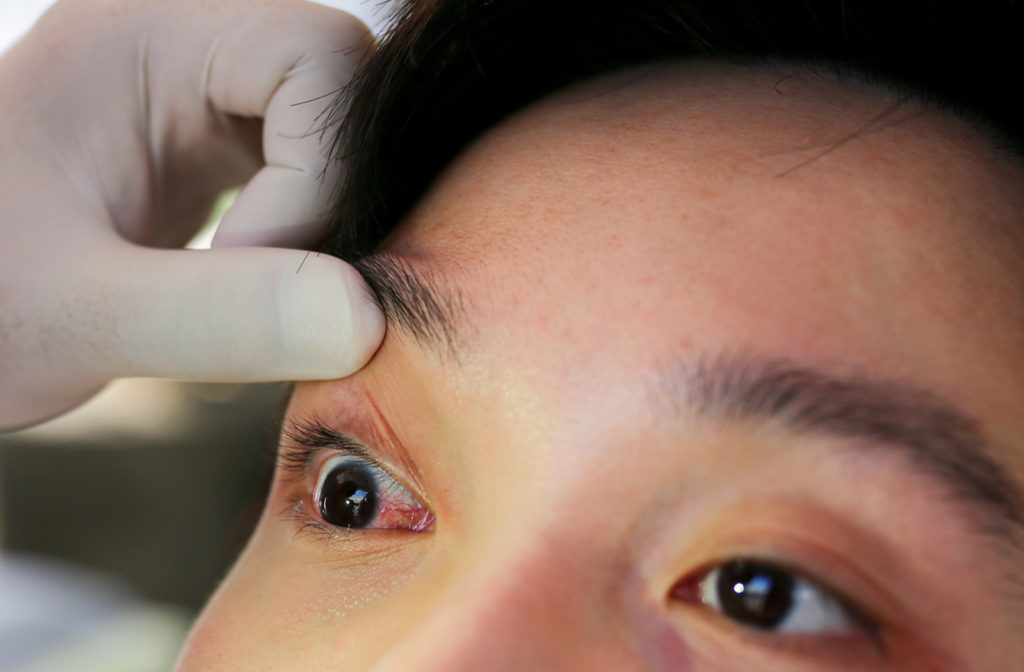Understanding the difference between ocular discomfort and an eye emergency can help preserve your vision. Although some situations clearly indicate an eye care emergency, not all forms of eye pain are so obvious.
So what’s the best way to know if you have an emergency? Contacting your optometrist is the surest way to know if your eye pain requires more attention. But understanding some of the signs of vision emergencies and knowing what to do, can help protect your eyes before professional assistance.
Causes of Eye Pain
Some forms of eye pain that may seem mild but have the potential to be more serious. Even a lingering pain or pain that is more annoying than debilitating is worth having your optometrist take a look at.
Orbital pain in and around the eyes can indicate some underlying issues that may require follow-up from a professional. Some of the root causes of eye pain include:
- Conjunctivitis (pink eye)
- Contact lens irritation
- Blepharitis (infection or inflammation)
- Glaucoma
- Sinus infection
- Migraine attack
- Physical injury
- Damaged optic nerve
Recognizing Eyecare Emergencies
Eye emergencies can come in many forms. The first thing to remember is not to panic. Instead, follow these immediate steps and proceed to an eye clinic or hospital. Aurora 2020 always prioritizes patients with an eye emergency and calling ahead will help prepare our doctors.
Signs of an Eye Emergency
Some general rules can be used to identify an eye emergency. These symptoms call for immediate help from an eye doctor. Make your way to our offices immediately if you experience the following symptoms:
- Sudden or rapidly progressing loss of vision
- Severe eye pain, especially if you cannot touch your eye
- Eye pain caused by trauma or exposure to a chemical or light
- Abdominal pain and vomiting that accompanies eye pain
Here are some of the most common eye pains and circumstances that constitute an emergency. If you are experiencing an eye emergency, follow the guidelines below and contact our office immediately.
Foreign Objects in the Eye
A foreign object can be anything that enters your eye, whether it rests underneath the eyelid or is stuck in the eye tissue. Do not rub your eye or try to remove a stuck object. This can cause further damage. Let a doctor assist as soon as possible.
You can attempt to loosen an object under the eyelid or on the eye’s surface with a cool water flush. Even if you are successful in dislodging the item, get immediate professional help.
Chemical Exposure to the Eyes
Our eyes are sensitive organs that can be damaged by exposure to chemicals. If you do get chemicals in your eyes, flush them immediately with cold water. Use cool, clean water and flush for at least 15 minutes.
It’s very important to continue to flush for a minimum of 15 minutes, even if irritation stops. Chemical residue may cause future damage, so you want to rinse all traces away.

Corneal Abrasions
The cornea is the front clear portion of the eye that is exposed when we open our eyelids. Corneal abrasions are scratches and cuts that occur on the surface of the eye. If left untreated, they can lead to infections and corneal ulcers.
Flush your eye with cool, clean water. Try pulling the upper eyelid over the lower eyelid. Seek medical attention.
Retinal Tears or Detachments
Retinal tears are often painless, so it’s very important to recognize the symptoms. Retinal damage can occur from physical trauma or other existing eye diseases.
Retinal tears are signalled by loss of peripheral vision, sudden flashes and specks floating across the field of vision, blurred vision, or a shadow over your field of vision. If these symptoms are present seek emergency eye care.
Always Err on the Side of Caution
Even when eye pain is manageable and doesn’t seem to be getting worse it’s the right idea to have your eyes examined. Optometrists are trained in finding irregularities in your eyes that you may not even feel. Modern optometric equipment allows professionals to take preventative action before eye pain becomes unbearable or irreversible.
Staying on top of annual eye exam visits is another great way to prevent eye pain from having any serious effects. The most important thing to remember is that being over-cautious is always smarter than acting tough or ignoring persistent pain. Let your optometrist take a look and recommend the best treatments to relieve your eyes.



